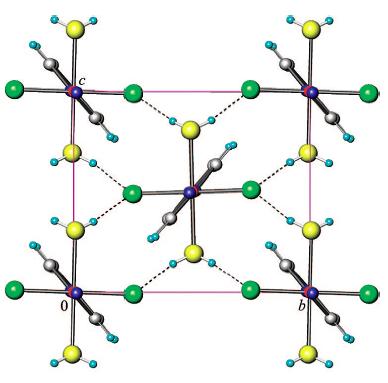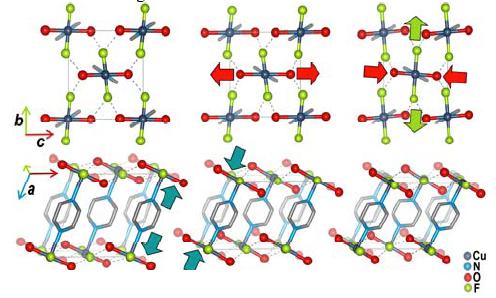Phy5670/JahnTellerEffect: Difference between revisions
| Line 56: | Line 56: | ||
==Solution To The Jahn-Teller Problem for an Idealized System == | ==Solution To The Jahn-Teller Problem for an Idealized System == | ||
== | == Pseudo Jahn-Teller and Renner-Teller Effect == | ||
The Pseudo Jahn-Teller effect is the vibronic coupling between a degenerate and a non-degenerate state which is induced by a | |||
degenerate mode. | |||
The Renner-Teller effect was first observed in 1959 by K. Dressler and D.A. Ramsay [7] in NH_2 and ND_2. | |||
== An Example of Jahn-Teller Distortion == | == An Example of Jahn-Teller Distortion == | ||
Revision as of 13:42, 16 November 2010
Introduction
The Jahn-Teller effect (JTE), also called Jahn Teller distortion, is the spontaneous geometrical distortion of a nonlinear molecule to lower the overall energy of the system by breaking the degeneracy of a ground or excited state. It was shown by Hermann Jahn and Edward Teller in 1937 that the orbital degeneracy of the electronic state in a polyatomic molecule cannot be stable unless the molecule is linear. They applied group theory to the perturbation calculation and examined the elements of the perturbation matrix. They showed that all the linear matrix elements vanish only if the molecule has complete axial symmetry (meaning the molecule is linear), and deduced that "all non-linear nuclear configurations are therefore unstable for an orbitally degenerate electronic state" [3]. By this reasoning it is possible to conclude that a polyatomic molecule that is not linear does not possess orbital degeneracy of the electronic ground state.
The Born-Oppenheimer Approximation
The Born-Oppenheimer approximation is often the preferred perturbative method in which to describe the JTE. The Born-Oppenheimer approximation, which is similar in some respects to the adiabatic approximation, is based on the largest contribution to a molecular spectra arising from the electronic motion, followed by the contribution of nuclear vibration, followed by nuclear rotation [1]. These three terms appear in increasing order with respect to , where is the electronic mass and is the average nuclear mass. Nuclear vibrations corresponds to second order, while nuclear rotational motion corresponds to fourth order in [1]. (The electronic motion is zeroth order in .)
In the BO approximation, the nuclei of atoms are assumed to be fixed in space, and therefore their kinetic energy can be neglected. Schrodinger's equation for the electrons is solved - while still including the Coulomb potential resulting from the interaction between the electrons and nuclei. This problem is solved repeatedly for very small changes in position, resulting in an expression for the electronic energy as a function of nuclei position. This is called the potential energy surface. The nuclear kinetic energy is the reintroduced to the Hamiltonian, and Schrodinger's equation is solved again, this time yielding the total energy of the molecule.
For the remained of this section I will define , is the local nuclear coordinate (where r can be x,y,z), is the electron coordinate (where q can be x,y,z). A subscript denotes an electronic quantity. A subscript denotes a nuclear quantity.
The total potential energy of the system is
where Q encompasses all electronic coordinates, and R encompasses all nuclear coordinates, and the sum on and the sum on represent the permutation of x,y,z.
The electronic kinetic energy is
The nuclear kinetic energy is
where is a dimensionless number on order 1 [1].
The Hamiltonian for a system of electrons and nuclei is given by:
where the potential has been broken into a part that relies only on the electron coordinates, and a part that includes the electron-nucleus interaction. Using the Born-Oppenheimer approximation we can write a pair of equations:
where is the electronic wave function (Q appears only as a constant in this particular equation), is the nuclear wave function, and is the effective potential as seen by each electronic state [2].
When the electronic states are non-degenerate, the Born-Oppenheimer wave-function are the solutions to the following Hamiltonian, where (the second line) is treated as a perturbation [2]:
with zero order solutions[2]:
When there are degenerate electronic states, the Born-Oppenheimer wave-function are the solutions to the following Hamiltonian [2]:
where represents the dimensionality of the degeneracy, and the sum is over all degenerate states. The zero order solutions are given by[2]:
Solution To The Jahn-Teller Problem for an Idealized System
Pseudo Jahn-Teller and Renner-Teller Effect
The Pseudo Jahn-Teller effect is the vibronic coupling between a degenerate and a non-degenerate state which is induced by a degenerate mode.
The Renner-Teller effect was first observed in 1959 by K. Dressler and D.A. Ramsay [7] in NH_2 and ND_2.
An Example of Jahn-Teller Distortion
The molecule CuF(HO)(pyz)(pyz = pyrazine) exhibits Jahn-Teller distortion. The CuF(HO)(pyz) is made of pyrazine-bridged CuFON octahedra. It exhibits Jahn-Teller distortion in the elongation of Cu-N bonds at ambient conditions. See reference [4] for additional information about the synthesis and characterization of this molecule. See reference [5] for additional information on pressure induced switching of the Jahn-Teller axes.
The structure and arrangement of CuF(HO)(pyz) molecules, from reference [4].

The pressure induced switching of the Jahn-Teller Axes, from reference [5].

References
[1] M. Born and R. J. Oppenheimer, Ann. Physik (Leipzig) 89, 457 (1927)
[2] R. Englman, The Jahn-Teller Effect in Molecules and Crystals John Wiley and Sons, 1972
[3] H.A. Jahn and E. Teller. Proc. Roy. Soc. A, 161, 220 (1937)
[4] Jamie L. Manson, et el. Chem. Mater., 2008, 20 (24) 7408-7416
[5] Halder, G. J., Chapman, K. W., Schlueter, J. A. and Manson, J. L. , Pressure-Induced Sequential Orbital Reorientation in a Magnetic Framework Material. Angewandte Chemie International Edition, n/a. doi: 10.1002/anie.201003380
[6] R. Renner, Z. Physik, 92, 172 (1934)
[7] Phil. Trans. Roy. Soc. London, 251A, 553 (1959)]















![{\displaystyle \left[T_{e}+V(R,Q)\right]\phi _{e}(R,Q)=W_{e}(Q)\phi _{e}(R,Q)}](https://wikimedia.org/api/rest_v1/media/math/render/svg/cd978ec7e981b3fb563eefbc05b250cdf3c7d846)
![{\displaystyle \left[T_{n}+W_{e}(Q)+V(Q)\right]\chi _{n}(Q)=E_{e}\chi _{n}(Q)}](https://wikimedia.org/api/rest_v1/media/math/render/svg/9ff00d5dc4353028217c3e85567f06a4b6d8e974)






![{\displaystyle H=H_{0}+\Delta H=\left(T_{e}+T_{n}+V(R,Q^{0})+V(Q^{0})+\sum _{e}\left({\frac {W_{e}(Q)-W_{e}(Q^{0})}{[\Gamma ]}}\right)\right)+\left(V(R,Q)-V(R,Q^{0})-\sum _{e}\left({\frac {W_{e}(Q)-W_{e}(Q^{0})}{[\Gamma ]}}\right)\right)}](https://wikimedia.org/api/rest_v1/media/math/render/svg/d5ca3d2e0c5526d14ff42ad89a7bbea236baeb34)
![{\displaystyle [\Gamma ]}](https://wikimedia.org/api/rest_v1/media/math/render/svg/2c98e49705831b0a31a81a0e7c3099006bd76ef4)

